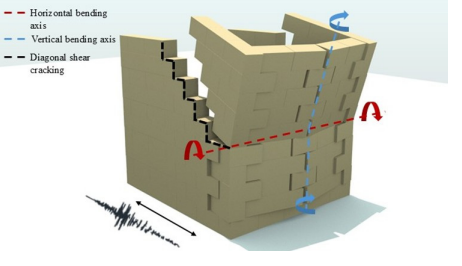Dario Vecchio, Babar Ilyas, Nuno Mendes, and Paulo B. Lourenço
i Ph.D. Student, University of Minho, ISISE, ARISE, Department of Civil Engineering, Guimarães, , dariovecchio4@yahoo.it
ii Ph.D. Student, University of Minho, ISISE, ARISE, Department of Civil Engineering, Guimarães, Portugal, babarilyas7@gmail.com
iii Researcher, University of Minho, ISISE, Department of Civil Engineering, Guimarães, Portugal, nunomendes@civil.uminho.com
iv Full Professor, University of Minho, ISISE, Guimarães, Portugal, pbl@civil.uminho.pt
ABSTRACT
Unreinforced masonry (URM) structures are vulnerable to strong earthquakes, due to their limited resistance to dynamic actions. These vulnerabilities often lead to failure or collapse, with out-of-plane mechanisms posing a major threat for existing structures not possessing integral (or box-like) behaviour. Despite the number of uncertainties within structural components, the response is usually governed by macro-elements, such as the main façade and orthogonal walls. Based on the degree of connection, URM structures may experience two types of out-of-plane mechanisms, namely one-way and two-way bending. The former involves a macro-element connected only at its top and bottom, leading to a vertical bending axis. In contrast, the latter occurs with two axes of bending, vertical and horizontal, given the additional connection with the orthogonal walls. Moreover, if the façade is insufficiently restrained at the top and lacks adequate connections with the return walls, overturning of the façade and cracking in the orthogonal walls may occur. Such a complex scenario challenges the understanding of the typical two-way bending behavior of URM structures. Predicting the total capacity of these mechanisms is challenging, and currently, the literature lacks adequate analytical and numerical models. This paper presents an extensive shake-table campaign conducted at the University of Minho to evaluate the two-way bending behaviour of URM structures. A specimen was constructed in a U-shape configuration consisting of a façade and two return walls, made of dry-stack granite blocks, to simulate the behaviour of historical URM structures, and to allow for testing repeatability at large displacements near collapse. The response of the specimen, with fixed geometry and boundary conditions, was observed under different recorded ground motions. The changes in the targeted hybrid mechanisms were observed and conclusions were drawn. Data collected is essential to update existing analytical formulations and to calibrate refined numerical models.
KEYWORDS: Shake table testing, U-shape, Out-of-plane, Overturning, Two-way, Collapse.
095-Vecchio.pdf



